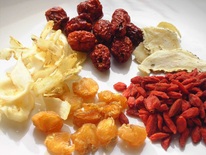
ingredients: ren shen, dong quai, huang qi, hong zao, lycii berry, chuan xiong, and dang shen.
Soon to come, I will be making ginseng (with other essential herbs) bone broth for order. Will be available in quart sizes.
A staple of the human diet for thousands of years, bone broth is enjoying a resurgence of interest due to its powerful health benefits. Bone broth is easy to incorporate in your diet as a base for soups, stews and legumes. Follow our recipe below to make your own fortifying and replenishing broth.
Top 5 Reasons to Eat Bone Broth:
1. Nourish Your Gut
Bone broth is full of gelatin and collagen, which soothes the intestinal tract and helps heal leaky gut, aka intestinal permeability. With stress, diet, alcohol, caffeine and NSAIDS wreaking havoc on our intestines, anything and everything we can do to help repair the gut is beneficial, as a healthy intestinal tract is essential to overall good health.
2. Boost Your Immune System
Yes, Grandma was right about chicken soup. A traditional folk remedy for colds and flus, bone broth provides a rich array of nutrients (especially gelatin) which support your immune system. Cysteine, an amino acid found in chicken, helps to thin mucus so it can be expelled more easily. When fighting a cold, make a chicken broth with added spices or peppers to make it spicy to help keep the mucus moving.
3. Increase Bio-available Minerals
As a result of soil degradation, the mineral content of our foods is reduced, and many of us have compromised absorption due to poor gut health. Yet minerals are critical to so many bodily functions and impact everything from our bones to our mood and our sleep. Supplying calcium, magnesium, potassium, silicon, sulfur and phosphorous, bone broth provides an excellent means of boosting your mineral intake.
4. Promote Healthy Skin
A rich source of skin-supporting amino acids glycine and proline, along with collagen, the ultimate skin food, bone broth can improve skin elasticity and fight wrinkles.
5. Reduce Inflammation
Glucosamine, chondroitin, collagen, and gelatin support your joints, bones, and reduce inflammation throughout your body.
How to Make Bone Broth
Broth is forgiving so exact measurements are not required for success. The essential ingredients are simply bones, water and vinegar, which draws the minerals out from the bones. Vegetables (carrots, garlic, onion), sea salt and herbs improve the flavor and can be added towards the end of the cooking time, if desired.
Ingredients:
- 2 – 4 lbs bones – from poultry, fish, shellfish, beef or lamb (pastured, organic, and grass-fed)
- 1 gallon water or enough to cover bones (approx. 2 cups of water per 1 pound of bones)
- 3 – 4 tablespoons of apple cider vinegar (or other natural vinegar)
Written by Be Well Health Coach Laura Kraber.
For educational purposes only. This information has not been evaluated by the Food and Drug Administration. This information is not intended to diagnose, treat, cure, or prevent any disease.
